Content for TS 23.287 Word version: 18.2.0
1…
4…
4.2.1.2…
4.2.2…
4.3…
5…
5.2…
5.3…
5.4…
5.4.2…
5.5
5.6…
5.7…
5.10…
6…
6.2…
6.3…
6.3.3…
6.4…
6.5…
A…
6.3.3 Unicast mode V2X communication over PC5 reference point
6.3.3.1 Layer-2 link establishment over PC5 reference point
6.3.3.2 Link identifier update for a unicast link
6.3.3.3 Layer-2 link release over PC5 reference point
6.3.3.4 Layer-2 link modification for a unicast link
6.3.3.5 Layer-2 link maintenance over PC5 reference point
...
...
6.3.3 Unicast mode V2X communication over PC5 reference point p. 47
6.3.3.1 Layer-2 link establishment over PC5 reference point p. 47
To perform unicast mode of V2X communication over PC5 reference point, the UE is configured with the related information as described in clause 5.1.2.1.
Figure 6.3.3.1-1 shows the layer-2 link establishment procedure for unicast mode of V2X communication over PC5 reference point.
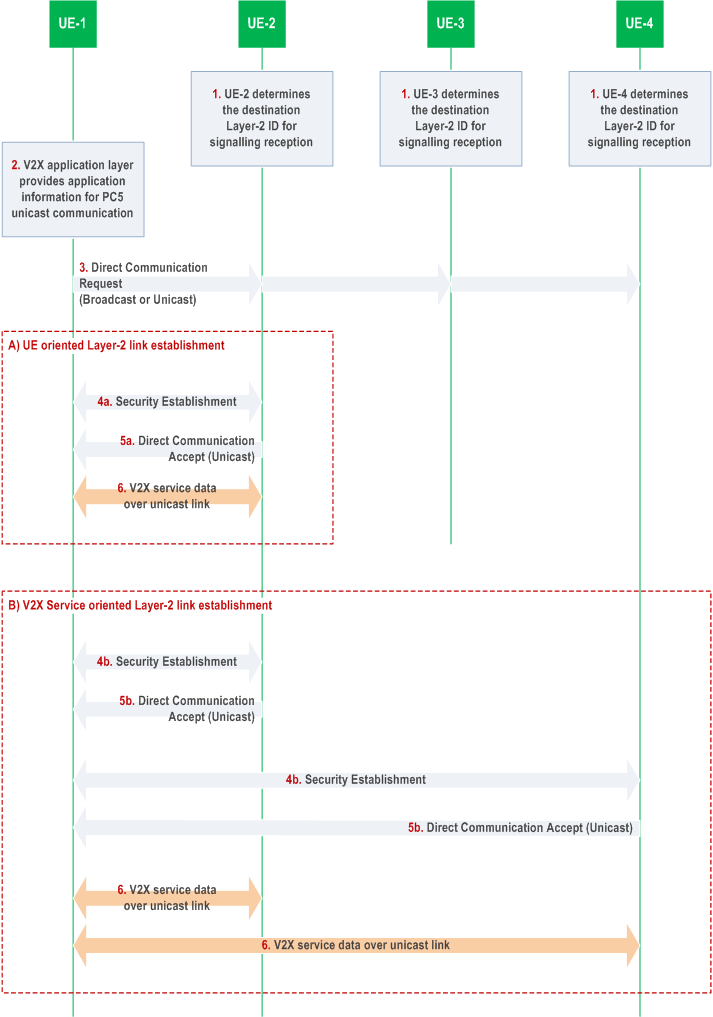
Step 1.
The UE(s) determine the destination Layer-2 ID for signalling reception for PC5 unicast link establishment as specified in clause 5.6.1.4. The destination Layer-2 ID is configured with the UE(s) as specified in clause 5.1.2.1.
Step 2.
The V2X application layer in UE-1 provides application information for PC5 unicast communication. The application information includes the V2X service type(s) and the initiating UE's Application Layer ID. The target UE's Application Layer ID may be included in the application information.
The V2X application layer in UE-1 may provide V2X Application Requirements for this unicast communication. UE-1 determines the PC5 QoS parameters and PFI as specified in clause 5.4.1.4.
If UE-1 decides to reuse the existing PC5 unicast link as specified in clause 5.2.1.4, the UE triggers Layer-2 link modification procedure as specified in clause 6.3.3.4.
Step 3.
UE-1 sends a Direct Communication Request message to initiate the unicast layer-2 link establishment procedure. The Direct Communication Request message includes:
Step 4.
- Source User Info: the initiating UE's Application Layer ID (i.e. UE-1's Application Layer ID).
-
If the V2X application layer provided the target UE's Application Layer ID in step 2, the following information is included:
- Target User Info: the target UE's Application Layer ID (i.e. UE-2's Application Layer ID).
- V2X Service Info: the information about V2X service type(s) requesting Layer-2 link establishment.
- Security Information: the information for the establishment of security.
Security with UE-1 is established as below:
Step 4a.
If the Target User Info is included in the Direct Communication Request message, the target UE, i.e. UE-2, responds by establishing the security with UE-1.
Step 4b.
If the Target User Info is not included in the Direct Communication Request message, the UEs that are interested in using the announced V2X service type(s) over a PC5 unicast link with UE-1 responds by establishing the security with UE-1.
When the security protection is enabled, UE-1 sends the following information to the target UE:
Step 5.
-
If IP communication is used:
-
IP Address Configuration: For IP communication, IP address configuration is required for this link and indicates one of the following values:
- "IPv6 Router" if IPv6 address allocation mechanism is supported by the initiating UE, i.e., acting as an IPv6 Router; or
- "IPv6 address allocation not supported" if IPv6 address allocation mechanism is not supported by the initiating UE.
- Link Local IPv6 Address: a link-local IPv6 address formed locally based on RFC 4862 if UE-1 does not support the IPv6 IP address allocation mechanism, i.e. the IP Address Configuration indicates "IPv6 address allocation not supported".
-
IP Address Configuration: For IP communication, IP address configuration is required for this link and indicates one of the following values:
- QoS Info: the information about PC5 QoS Flow(s) to be added. For each PC5 QoS Flow, the PFI, the corresponding PC5 QoS parameters (i.e. PQI and conditionally other parameters such as MFBR/GFBR, etc.) and the associated V2X service type(s).
A Direct Communication Accept message is sent to UE-1 by the target UE(s) that has successfully established security with UE-1:
Step 5a.
(UE oriented Layer-2 link establishment) If the Target User Info is included in the Direct Communication Request message, the target UE, i.e. UE-2 responds with a Direct Communication Accept message if the Application Layer ID for UE-2 matches.
Step 5b.
(V2X Service oriented Layer-2 link establishment) If the Target User Info is not included in the Direct Communication Request message, the UEs that are interested in using the announced V2X Service(s) respond to the request by sending a Direct Communication Accept message (UE-2 and UE-4 in Figure 6.3.3.1-1).
The Direct Communication Accept message includes:
Step 6.
- Source User Info: Application Layer ID of the UE sending the Direct Communication Accept message.
- QoS Info: the information about PC5 QoS Flow(s) requested by UE-1. For each PC5 QoS Flow, the PFI, the corresponding PC5 QoS parameters (i.e. PQI and conditionally other parameters such as MFBR/GFBR, etc.) and the associated V2X service type(s).
-
If IP communication is used:
-
IP Address Configuration: For IP communication, IP address configuration is required for this link and indicates one of the following values:
- "IPv6 Router" if IPv6 address allocation mechanism is supported by the target UE, i.e., acting as an IPv6 Router; or
- "IPv6 address allocation not supported" if IPv6 address allocation mechanism is not supported by the target UE.
- Link Local IPv6 Address: a link-local IPv6 address formed locally based on RFC 4862 if the target UE does not support the IPv6 IP address allocation mechanism, i.e. the IP Address Configuration indicates "IPv6 address allocation not supported", and UE-1 included a link-local IPv6 address in the Direct Communication Request message. The target UE shall include a non-conflicting link-local IPv6 address.
-
IP Address Configuration: For IP communication, IP address configuration is required for this link and indicates one of the following values:
V2X service data is transmitted over the established unicast link as below:
The PC5 Link Identifier, and PFI are provided to the AS layer, together with the V2X service data.
Optionally in addition, the Layer-2 ID information (i.e. source Layer-2 ID and destination Layer-2 ID) is provided to the AS layer.
UE-1 sends the V2X service data using the source Layer-2 ID (i.e. UE-1's Layer-2 ID for this unicast link) and the destination Layer-2 ID (i.e. the peer UE's Layer-2 ID for this unicast link).
6.3.3.2 Link identifier update for a unicast link p. 51
Figure 6.3.3.2-1 shows the link identifier update procedure for a unicast link. When privacy requirements is configured for a V2X service type associated with the unicast link, identifiers used for unicast mode of V2X communication over PC5 reference point (e.g. Application Layer ID, Source Layer-2 ID and IP address/prefix) shall be changed over time as specified in clause 5.6.1.1 and clause 5.6.1.4. A UE may decide to change the identifiers for other reasons, e.g. application layer requirement. This procedure is used to update and exchange new identifiers between the source and the peer UEs for a unicast link before using the new identifiers, to prevent service interruptions. When there are privacy requirements as indicated above, this procedure is executed over a security protected unicast link.
If a UE has multiple unicast links using the same Application Layer IDs or Layer-2 IDs, the UE needs to perform the link identifier update procedure over each of the unicast link.
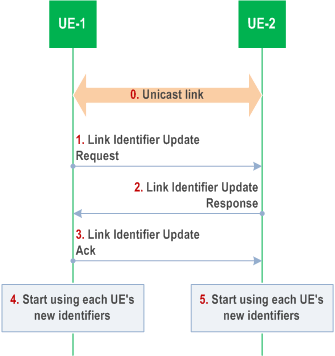
Step 0.
UE-1 and UE-2 have a unicast link established as described in clause 6.3.3.1.
Step 1.
UE-1 decides to change its identifier(s), e.g. due to the Application Layer ID change or upon expiry of a timer. UE-1 generates its new Layer-2 ID and sends a Link Identifier Update Request message to UE-2 using the old identifiers.
The Link Identifier Update Request message includes the new identifier(s) to use (including the new Layer-2 ID, Security Information, optionally the new Application Layer ID and optionally new IP address/prefix if IP communication is used). The new identifier(s) shall be cyphered to protect privacy if security is configured for the unicast link. After sending the Link Identifier Update Request message, if the UE-1 has data to send, UE-1 keeps sending data traffic to UE-2 with the old identifiers until UE-1 sends the Link Identifier Update Ack message to UE-2.
Step 2.
Upon reception of the Link Identifier Update Request message, UE-2 changes its identifier(s). UE-2 responds with a Link Identifier Update Response message which includes the new identifier(s) to use (including the new Layer-2 ID, Security Information, optionally the new Application Layer ID, and optionally a new IP address/prefix if IP communication is used). The new identifier(s) shall be cyphered to protect privacy if security is configured for the unicast link. The Link Identifier Update Response message is sent using the old identifiers. UE-2 continues to receive traffic with the old Layer-2 ID from UE-1 until UE-2 receives traffic with the new Layer-2 ID from UE-1. After sending the Link Identifier Update Response message, UE-2 keeps sending data traffic to UE-1 with the old identifiers, if UE-2 has data to send, until UE-2 receives the Link Identifier Update Ack message from UE-1.
Step 3.
Upon reception of the Link Identifier Update Response message, UE-1 responds with a Link Identifier Update Ack message. The Link Identifier Update Ack message includes the new identifier(s) from UE-2, as received on the Link Identifier Update Response message. The Link Identifier Update Ack message is sent using the old identifiers. UE-1 continues to receive traffic with the old Layer-2 ID from UE-2 until UE-1 receives traffic with the new Layer-2 ID from UE-2.
Step 4.
The V2X layer of UE-1 passes the PC5 Link Identifier for the unicast link and the updated Layer-2 IDs (i.e. new Layer-2 ID for UE-1 for the source and new Layer-2 ID of UE-2 for the destination) down to the AS layer. This enables the AS layer to update the provided Layer-2 IDs for the unicast link.
UE-1 starts using its new identifiers and UE-2's new identifiers for this unicast link.
Step 5.
Upon reception of the Link Identifier Update Ack message, the V2X layer of UE-2 passes the PC5 Link Identifier for the unicast link and the updated Layer-2 IDs (i.e. new Layer-2 ID of UE-2 for the source and new Layer-2 ID for UE-1 for the destination) down to the AS layer. This enables the AS layer to update the provided Layer-2 IDs for the unicast link.
UE-2 starts using its new identifiers and UE-1's new identifiers for this unicast link.
6.3.3.3 Layer-2 link release over PC5 reference point p. 52
Figure 6.3.3.3-1 shows the layer-2 link release procedure over PC5 reference point.
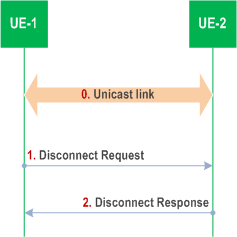
Step 0.
UE-1 and UE-2 have a unicast link established as described in clause 6.3.3.1.
Step 1.
UE-1 sends a Disconnect Request message to UE-2 in order to release the layer-2 link and deletes all context data associated with the layer-2 link. The Disconnect Request message includes Security Information.
Step 2.
Upon reception of the Disconnect Request message UE-2 may respond with a Disconnect Response message and deletes all context data associated with the layer-2 link. The Disconnect Response message includes Security Information.
The V2X layer of each UE informs the AS layer that the unicast link has been released. The V2X layer uses PC5 Link Identifier to indicate the released unicast link. This enables the AS layer to delete the context related to the released unicast link.
6.3.3.4 Layer-2 link modification for a unicast link p. 52
Figure 6.3.3.4-1 shows the layer-2 link modification procedure for a unicast link. This procedure is used to:
-
add new PC5 QoS Flow(s) in the existing PC5 unicast link.
- This covers the case for adding new PC5 QoS Flow(s) to the exisiting V2X service(s) as well as the case for adding new PC5 QoS Flow(s) to new V2X service(s).
-
modify existing PC5 QoS Flow(s) in the existing PC5 unicast link.
- This covers the case for modifying the PC5 QoS parameters for existing PC5 QoS Flow(s).
- This also covers the case for removing the associated V2X service(s) from existing PC5 QoS Flow(s) as well as the case for associating new V2X service(s) with existing PC5 QoS Flow(s).
- remove existing PC5 QoS Flow(s) in the existing PC5 unicast link.
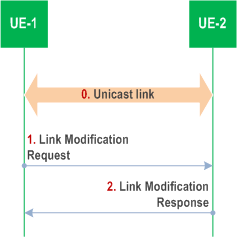
Step 0.
UE-1 and UE-2 have a unicast link established as described in clause 6.3.3.1.
Step 1.
The V2X application layer in UE-1 provides application information for PC5 unicast communication. The application information includes the V2X service type(s) and the initiating UE's Application Layer ID. The target UE's Application Layer ID may be included in the application information. If UE-1 decides to reuse the existing PC5 unicast link as specified in clause 5.2.1.4, so decides to modify the unicast link established with UE-2, UE-1 sends a Link Modification Request to UE-2.
The Link Modification Request message includes:
Step 2.
-
To add new PC5 QoS Flow(s) in the existing PC5 unicast link:
- QoS Info: the information about PC5 QoS Flow(s) to be added. For each PC5 QoS Flow, the PFI, the corresponding PC5 QoS parameters (i.e. PQI and conditionally other parameters such as MFBR/GFBR, etc.) and the associated V2X service type(s).
-
To modify PC5 QoS Flow(s) in the existing PC5 unicast link:
- QoS Info: the information about PC5 QoS Flow(s) to be modified. For each PC5 QoS Flow, the PFI, the corresponding PC5 QoS parameters (i.e. PQI and conditionally other parameters such as MFBR/GFBR, etc.) and the associated V2X service type(s).
-
To remove PC5 QoS Flow(s) in the existing PC5 unicast link:
- PFI(s).
UE-2 responds with a Link Modification Accept message.
The Link Modification Accept message includes:
-
For case a) and case b) described in step 1:
- QoS Info: the information about PC5 QoS Flow(s) requested by UE-1. For each PC5 QoS Flow, the PFI, the corresponding PC5 QoS parameters (i.e. PQI and conditionally other parameters such as MFBR/GFBR, etc.) and the associated V2X service type(s).
6.3.3.5 Layer-2 link maintenance over PC5 reference point p. 53
The PC5 Signalling Protocol shall support keep-alive functionality that is used to detect if a particular PC5 unicast link is still valid. Either side of the PC5 unicast link can initiate the layer-2 link maintenance procedure (i.e. keep-alive procedure), based on for example triggers from the AS layer or internal timers. The UEs shall minimize the keep-alive signalling, e.g. cancel the procedure if data are successfully received over the PC5 unicast link.
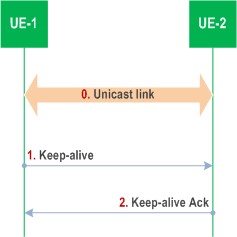
Step 0.
The UE initiating the keep-alive procedure shall determine the follow up actions based on the result of the signalling, e.g. proceed with implicit layer-2 link release.
UE-1 and UE-2 have a unicast link established as described in clause 6.3.3.1.
Step 1.
Based on trigger conditions, UE-1 sends a Keep-alive message to UE-2 in order to determine the status of the PC5 unicast link.
Step 2.
Upon reception of the Keep-alive message, UE-2 responds with a Keep-alive Ack message.